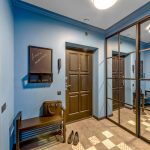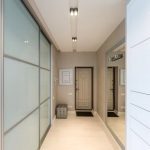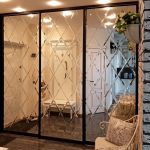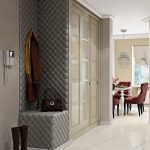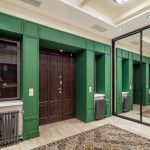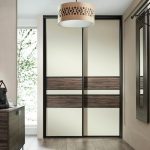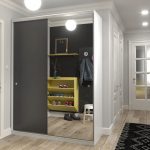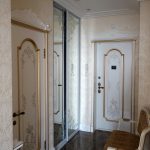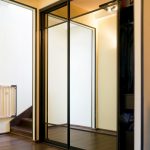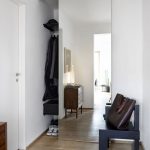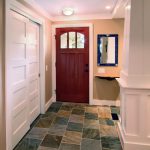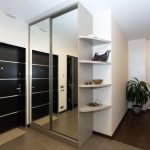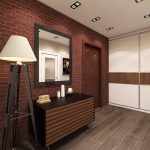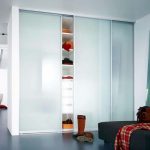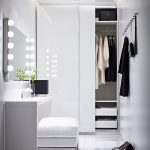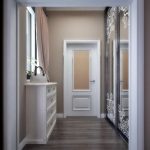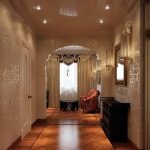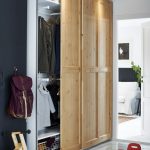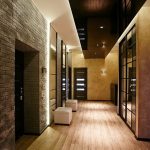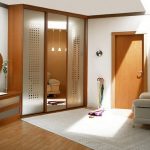The sliding wardrobe in the hallway - the photos clearly demonstrate the varieties of the product - is one of the most necessary elements of furniture in the room. Its design and dimensions are selected taking into account the characteristics of the corridor. Internal filling should be well thought out so that it is possible to rationally use every centimeter of space. Due to the variety of facade designs, the product can harmoniously fit into any room interior.
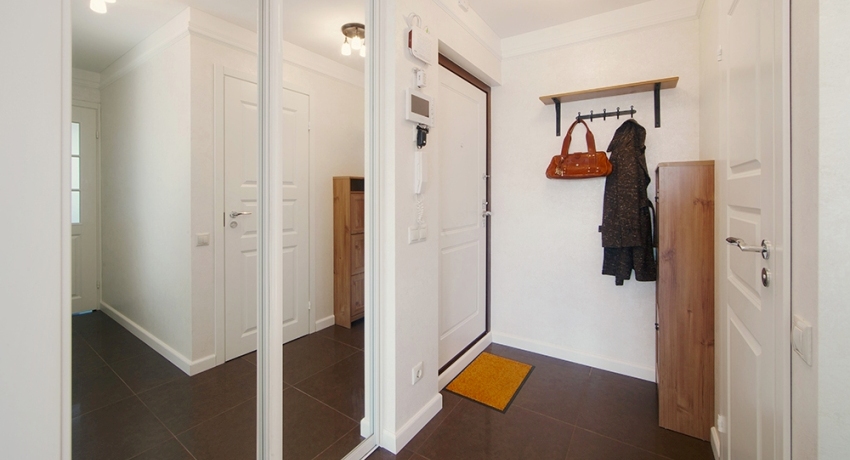
The main advantage of wardrobes for the hallway is the variety of designs, installation and design variations
Content [Hide]
- 1 What can be a wardrobe in the hallway: photo options
- 2 Which is better to choose a wardrobe for the hallway
- 3 Configurations of built-in wardrobes in the hallway
- 4 How to choose the right wardrobe size for the hallway
- 5 Recommendations for filling wardrobes in the hallway
- 6 Material used for the manufacture of built-in wardrobes in the hallway
- 7 Facade options for built-in wardrobes in the hallway: photo examples
- 8 Assembling the built-in wardrobe in the hallway with your own hands
What can be a wardrobe in the hallway: photo options
When decorating a corridor space, a special approach is required. Usually, the room is not large in size and has structural features, which are manifested in the presence of niches, outer corners and interior doors, which complicates the process of furnishing the corridor. In this confined space, you need to balance functionality and aesthetics.
IN hallway you can install a wardrobe, a product with swing doors and a combined structure. The first option is the most popular and demanded solution. Thanks to the ergonomic sliding doors, this design will fit even into narrow and confined spaces. Due to the diversity of the design of the front of the hallway cabinets - the photos clearly demonstrate this - the corridor will acquire a well-groomed, stylish and presentable appearance. Outerwear, seasonal footwear, hats and other accessories will be hidden behind the sliding structure from prying eyes.
The reliability and durability of the doors depends on the material of the frame, where the canvases move. Aluminum products are considered to be of higher quality. They provide silent running of the canvases, do not deform and serve for a long time. Steel guides are cheaper. Their service life does not exceed 5-8 years.

The sliding wardrobe is perfect for hallways of different sizes, it can be easily built into any niche
Important! The compartment system takes up to 10 cm of internal space, so the shelves will have a smaller width than the structure itself.
Traditional configuration of hallway cabinets
Wardrobes with swing doors, reminiscent of pencil cases, need a lot of space to open the structure. Internal content is no different from the previous version. This model is most often installed in a spacious hallway, cabinet photos show possible design options. A closed product is usually made from natural wood. The facade is decorated with decorative carvings and forged fittings, which creates a respectable appearance of the product, emphasizing the delicate taste of the owner of the apartment.
Very often you can find in hallway an open-type cabinet built into a niche, which is devoid of opening doors. This option looks minimalistic, but it is the most convenient to use, as it allows you to quickly remove clothes from the hook or take the necessary accessory from a shelf or drawer. However, since all the contents of the structure are in plain sight, things in the closet must be neatly arranged so that the room does not resemble chaos.
Combined models are a combination of closed and open cabinets. A small pencil case can be located here. The open part is represented by shelves and hooks, and in its lower space you can equip a comfortable small ottoman. It is used not only for sitting - in its cavity you can equip a space for storing various things.

Combined models are considered the most convenient for the hallway, which are a combination of closed and open cabinets.
Which is better to choose a wardrobe for the hallway
The best option for hallway is a wardrobe with a sliding door system. Due to the fact that the product can be shallow (only 45 cm), a lot of space is not required to install the structure. This is enough to accommodate outerwear, shoes and everyday accessories. Sliding doors allow you to save space by not having to have free space to open them.
There are two design options: freestanding and built-in wardrobe. The first type is a full-fledged model, consisting of a frame, interior elements and sliding doors. The structure can be moved from place to place. Such a cabinet is usually used for rooms with a large area, where you do not have to save space. The disadvantages of the product are its high cost, which is associated with high material costs, and a relatively small usable area (due to the presence of a frame). In addition, dust accumulates in the upper part of the structure due to the formation of a gap between the product and the ceiling.

There are practically no drawbacks to sliding wardrobes, except for the inconvenience of sliding doors, which, opening some shelves, close others
Built-in models are quite common in modern hallways. This design is made to order in the hallway. The built-in cabinet can be installed in any confined space. Such a product does not have its own walls, ceiling and floor, since they are replaced by elements of the room, to which the filling and cabinet doors are attached. This allows you to significantly save on materials, so this design will be inexpensive. Photos of built-in wardrobes and product prices can be seen in catalogs from well-known manufacturers.
Such a cabinet is as spacious as possible and allows you to fully use the space allocated for it. The design of the product can be created taking into account the peculiarities of the corridor layout. It covers the entire area from floor to ceiling, which eliminates the accumulation of dust on a horizontal surface. The main disadvantage of a built-in piece of furniture is its stationarity.

The cabinet models of the sliding wardrobe leave a gap to the ceiling, and the built-in ones completely cover the entire wall
Configurations of built-in wardrobes in the hallway
The design of the built-in wardrobe completely repeats the layout of its installation site. The product can be mounted in a niche, in a corner, or occupy the space between two walls. For small-sized corridors, the most rational option is the corner structure. In this case, it is possible to use the dead small area of the room as efficiently as possible by organizing a compact storage system there. This design will free up space along the walls, making the room seem more spacious and comfortable.
The corner wardrobe built into the hallway consists of elements of internal filling and sliding doors. A variation of the corner model is a trapezoidal structure, which is additionally equipped with side edges. Such a cabinet is more spacious than a simple triangular counterpart. The outer sides of the structure can be equipped with open shelves to accommodate various small items.
The rectangular module is also very popular due to its low cost and original design of the facade, which can be made in any stylistic direction. The structure fills the area of the room along one of the walls. It can have different depths, depending on the availability of free space.
The most difficult and expensive to implement are radius wardrobes, in which the movement of the doors is carried out along the radius of the circle. The facade of such structures is made of expensive materials using a special technology, which significantly increases the price of a wardrobe built into the hallway. However, this is offset by a spectacular, stylish, original and unique appearance. This model is able to fit into any layout due to the ergonomic door opening. The disadvantage of the cabinet is the inability to use mirrors and chipboard in the manufacture of doors.

A common configuration of a built-in wardrobe is a model in which the walls of the room itself take on the role of the walls
Helpful advice! The radius compartment does not have straight and sharp corners, which makes it less traumatic and suitable for homes with children.
How to choose the right wardrobe size for the hallway
As mentioned earlier, the wardrobe in the hallway can be located in a corner, in a niche or along one of the walls. The size of the structure depends on this. In the hallway, built-in corner cabinets and rectangular products can have different dimensions. If the cabinet is mounted in a niche, then in this case there are certain restrictions that depend on its depth, height and width. The last parameter determines the number of doors. Two-door wardrobes are suitable for niches 1.5-2 m wide, three-door - 2-3 m, four-door - 2.5-4 m. Too narrow doors will fall out of the lower grooves, and wide ones will deform over time.
Important! The width of the compartment doors should not exceed 0.5-1 m.

From where exactly in hallway there will be a wardrobe, its size will depend
It is necessary that the niche is completely closed in height by doors, however, the frame cannot exceed 2.7-2.8 m. A higher structure will be deprived of the necessary stability and rigidity. If the room has high ceilings, which are also characteristic of a niche, the doors should be made from separate segments, and different materials can be used. Options for a spectacular and unique facade design are shown in the photo of built-in wardrobes in the hallway.
Related article:
Corner wardrobe in the bedroom: a spacious and multifunctional element of the room
Organization of internal content. Product dimensions. Types and design of doors. Manufacturing material. Manufacturers.
For a full-fledged wardrobe, the niche should have a depth of 0.6-0.7 m.If this value is less, the filling for such a structure is provided for narrow corridors. If the wardrobe is less than 40 cm deep, the shelves of the structure will be ineffective, since their width will be about 30 cm. If the niche is deeper than 1 m, in this case it becomes possible to create a full-fledged wardrobe room. However, here the internal filling should be properly organized so that the cabinet is convenient during operation.
Recommendations for filling wardrobes in the hallway
Corridor cabinets are more specialized. The structures do not differ in large dimensions, since they are designed to store outerwear and seasonal shoes. It does not use special holders for ties and trousers, and does not use drawers for underwear, socks and belts.
Internal filling of the wardrobe in the hallway can be fixed or combined. The first option clearly defines the location of shelves, drawers and hangers. Combined models are equipped with removable shelves, places for fasteners and other elements that allow you to subsequently change the location of the internal filling. Despite the fact that the latter option is much more convenient, in terms of reliability, this solution loses.
Outerwear is stored exclusively on hangers, so most of the internal space is allocated under a niche with a bar. If the closet is narrow double-winged, then both compartments are occupied by hanging clothes. Shelves can be located at the top and bottom of the structure. In the case of a three-piece wardrobe, one compartment is used for stationary or sliding shelves, which is clearly visible in the photo of sliding wardrobes in the corridor.
Helpful advice! In a small-sized wardrobe, the inner space can be zoned in this way: in one compartment there is a long outer garment, in the other - a shorter one, which allows you to equip a niche with additional shelves.
With a construction depth of 50-60 cm, a conventional bar is mounted parallel to the doors. If the cabinet is narrow, 30-45 cm deep, the end bar is used. The capacity of this design is much less, however, you can fix the matter with the help of a retractable hanger. It is not recommended to install a pantograph for a wardrobe in the hallway. The constant descent and ascent of the structure is difficult and tedious.
The top shelf is used to house hats, scarves and gloves. For the placement of shoes, it is recommended to use inclined metal nets, which are located in the lower part of the cabinet. If space permits, you can equip several drawers for storing shoe care products and various accessories. If the design has a side wall, you can place hooks for bags and hats on it. Various options for filling the closet in the hallway can be seen in numerous photos on the Internet.

When choosing a ready-made wardrobe or ordering an individual one, you need to pay attention to the capacity of shelves, drawers, the number and purpose of rods for clothes
Important! The fittings for the closet in the corridor should be as strong as possible, since it will take a higher load than the furniture in other rooms.
Material used for the manufacture of built-in wardrobes in the hallway
The fundamental factor that affects the reliability, durability and appearance of furniture is the material of manufacture. The built-in wardrobe to order in the hallway can be made of chipboard, MDF, natural wood and plywood. The first option is an affordable alternative to natural material. With high-quality cladding, the product is capable of completely imitating wood. There are several types of chipboard, which differ in the amount of formaldehyde resins in the composition of the substance.For residential premises, type E1 should be used, which is the most environmentally friendly material with a low content of harmful substances.
To ensure durability and moisture resistance, the material is covered with a special protective film, which prolongs the life of the product. However, at the slightest violation of such a finish, the chipboard begins to collapse. The material is characterized by a wide range of species, but its appearance is devoid of elegance and originality.
An equally popular option for making a built-in wardrobe to order is MDF. The material is characterized by density, moisture resistance, strength and durability. A wide range of products, which is achieved by covering the plywood surface with veneer, vinyl or melamine paper, allows you to choose an option for any interior.

A sliding wardrobe made of MDF will cost more than a similar sliding wardrobe made of chipboard, since this material is very durable and resistant to moisture
Natural wood has significant advantages over chipboard and MDF (regarding the quality and environmental friendliness of the material). The wooden structure has a solid and presentable appearance, which is clearly visible in the photo of the design of the cabinets in the hallway. The material is characterized by strength, wear resistance, practicality and durability. However, such a wardrobe built into the corridor will have a high cost.
Helpful advice! It is not recommended to install a wooden structure in rooms with high humidity, as the product may deform.
Plywood is a multi-layer wood material consisting of veneer sheets glued together. The surface can be laminated, varnished or painted. This material can be combined with other options, due to which it will be possible to obtain an attractive design of the wardrobe in the hallway. Photos clearly display various design ideas.
Facade options for built-in wardrobes in the hallway: photo examples
When choosing material for the facade, you should be guided by the door opening system. Swing elements are best made of chipboard, MDF or plastic. For the sliding system, you can use any material.

Natural wood in the manufacture of sliding wardrobes is rarely used due to the high cost of construction
The chipboard facade is the cheapest option, acceptable for families with any income. The material is characterized by durability, environmental friendliness, resistance to dirt and moisture. The surface can be laminated or finished with natural veneer of oak, beech, pine or ash, as shown in the photo of wardrobes for the hallway. This option is suitable for classic-style corridors.
The MDF facade is also characterized by high performance. A smooth and even surface can be painted in any color, which allows the product to fit into any interior of the hallway, a photo of MDF sliding wardrobes is a clear confirmation of this.
Important! The ends of surfaces made of MDF and chipboard are covered with a reliable PVC film, which protects the product from moisture and damage, giving the material a neat appearance.
Rattan and bamboo facades look interesting and natural. Such furniture gives the room a feeling of warmth, naturalness and naturalness. It is relevant for corridors created in ethnic style. The design of the wardrobe in the hallway, made of artificial leather, will look luxurious and stylish. The model will become a real decoration of the corridor, decorated in a modern interpretation or in baroque style.
Sliding wardrobe in the hallway: photo modelher with mirrored, glass and plastic facades
The most popular among other options is a mirrored facade, the variations of the use of which are displayed in the photo of sliding wardrobes in a small hallway. It always looks stylish and original, which is ideal for rooms decorated in the style of minimalism, loft and high-tech. The mirror blends harmoniously with different materials. The surface can be sandblasted or photoprinted. Using modern technologies, complex and voluminous drawings and patterns can be created on the mirror - this is clearly displayed in the photo of the design of the built-in wardrobes in the hallway.
Often in the corridor you can find a structure with a glass facade. In this case, a matte material is often used, which allows you to achieve the effect of translucency, protecting the inner filling from prying eyes, and at the same time visually increase the size of the room. So you can arrange a built-in wardrobe in a small hallway. In addition, transparent glass is used, on the reverse side of which a decorative PVC film is attached with special additives that increase the strength and durability of the structure. Such a glass facade can be monochromatic, multi-colored or with various abstract and mosaic patterns.
Prints on all doors are very popular, which are combined into a single composition in the closed position. During their movement, the image becomes three-dimensional. This effect is clearly demonstrated in the photo of the built-in wardrobes in the hallway.
Important! If the surface of the facade is damaged, the debris will not scatter to the sides, as they will be held by the film.
For the manufacture of the facade of radius models, acrylic plastic is very often used, which can be matte or glossy. The material is characterized by a relatively low weight, which reduces the load on the profile, while increasing the life of the furniture. A drawing is applied to the acrylic, or the surface is decorated with a filling of flowers, leaves or coffee beans - this is clearly demonstrated by photos of corner built-in wardrobes in the hallway.
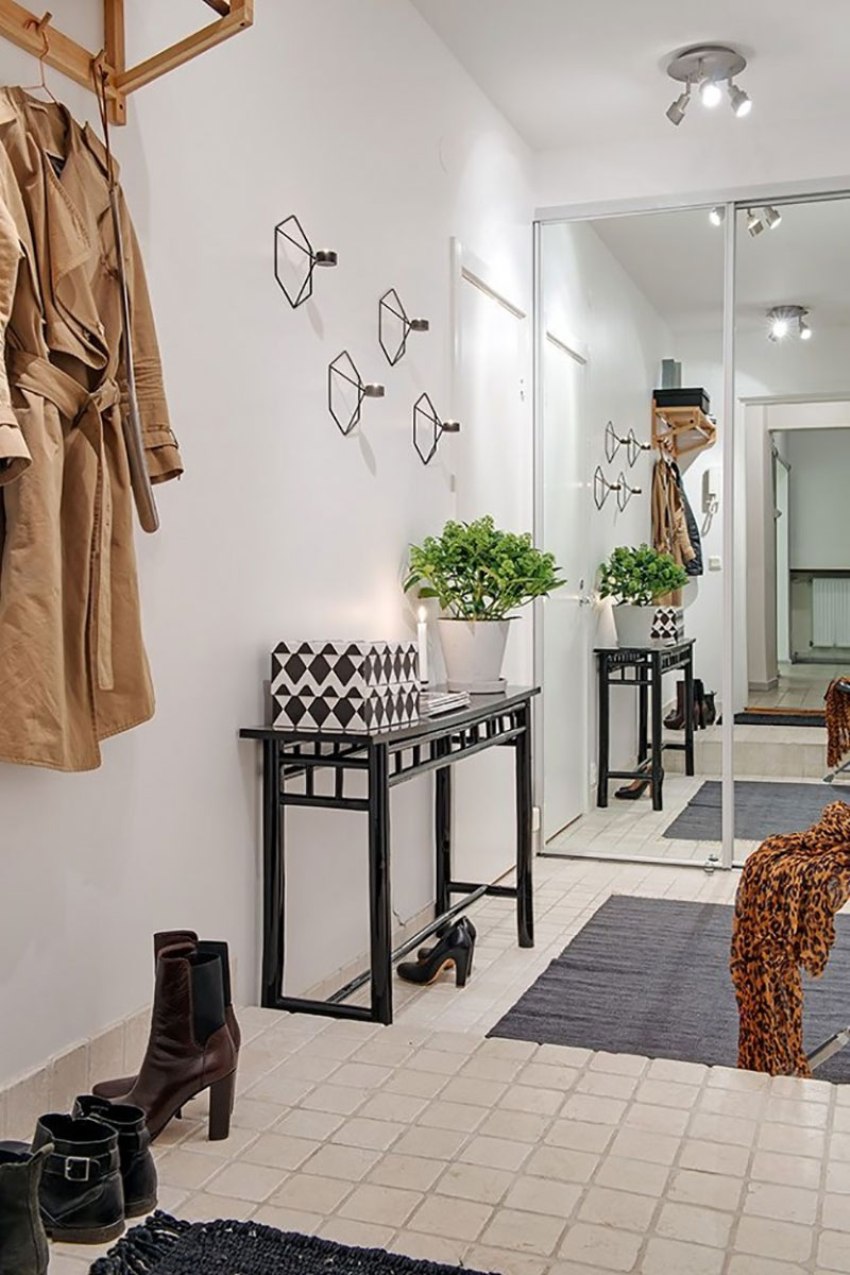
Mirrored doors installed in the wardrobe will expand the space, making the hallway noticeably larger
Assembling the built-in wardrobe in the hallway with your own hands
The assembly of a modern built-in wardrobe in the hallway begins with the installation of the main walls. The frame elements are fixed to the ceiling, walls and floor with dowels. Corners are used to connect the parts together. To make the design look beautiful, you should use plastic elements that cover the caps of the screws. For structural reliability, you can use steel corners.
A modern option for attaching furniture elements to each other is the use of Euro screws. However, they require pre-drilling the holes with a confirmation. Furniture dowels are used to give the structure additional rigidity. Euro screws are screwed in by means of a hexagon. Caps are inserted into their hats to match the color of the cabinet.
After the base is installed, partitions and shelves are installed, which can be fixed with corners, confirmants, eccentrics or shelf supports. The first option is considered the simplest, cheapest and most primitive. For heavy loads use Euro screws. A reliable, but laborious fastening is the eccentric, the head of which will be visible from the bottom of the shelf. The best invisible option is shelf supports.
Helpful advice! Confirmants must be installed exclusively in invisible places so that the hats do not spoil the appearance of the structure.

Self-made assembly of the wardrobe will not only bring pleasure, but also save on the services of a specialist
The final and most important stage is the installation of sliding doors.Installation begins with the fastening of the cross profiles, which are hammered in with a rubber hammer. Further, horizontal guides are mounted using screws. The upper element is used to fix the doors relative to their depth, the lower one provides opening and closing.
The choice of a wardrobe in the hallway is a very responsible event. The design should become not only a convenient storage system, but also a stylish element of the corridor.









